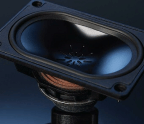I used DRA Labs’ MLSSA system, a calibrated DPA 4006 microphone, and an Earthworks microphone preamplifier to measure the TAD Grand Evolution 1’s quasi-anechoic frequency- and time-domain behavior in the farfield. I used an Earthworks QTC-40 microphone, which has a small, ¼" diameter capsule, for the nearfield responses. I examined the loudspeaker’s impedance with Dayton Audio’s DATS V2 system.
My B-weighted estimate of the GE1’s voltage sensitivity was 87.5dB(B)/2.83V/m, which is within experimental error of the specified 88dB/2.83V/m. TAD specifies the GE1’s is significantly lower. The EPDR lies below 3 ohms below 30Hz, between 43Hz and 95Hz, between 197Hz and 1183Hz, and above 7kHz. The minimum EPDR values are 1.6 ohms at 27Hz, 1.76 ohms at 56Hz, and 2 ohms at 608Hz. The GE1 is a very demanding load for the partnering amplifier.




